Business Central Insights Supply Chain Delivery Analytics
 Unlock unparalleled insights into your delivery operations with Business Central Supply Chain Delivery Analytics Reports. These comprehensive reports enable informed, data-driven decisions, enhancing operational efficiency and elevating customer satisfaction. Gain a holistic understanding of your supply chain dynamics and then delve into a detailed analysis of your delivery performance, encompassing Delivery Days and Variances, On-Time Delivery, and Fill Rate.
Unlock unparalleled insights into your delivery operations with Business Central Supply Chain Delivery Analytics Reports. These comprehensive reports enable informed, data-driven decisions, enhancing operational efficiency and elevating customer satisfaction. Gain a holistic understanding of your supply chain dynamics and then delve into a detailed analysis of your delivery performance, encompassing Delivery Days and Variances, On-Time Delivery, and Fill Rate.
Delivery Days
The Delivery Days report allows you to compare your Actual Delivery Days with the Requested, Planned, or Promised Delivery Days. The 'Actual Delivery Days' metric measures the average time it takes to complete a delivery from when the order is placed to its arrival at the customer's doorstep.
Whether you''re interested in the Requested, Promised, or Planned Delivery Date, our report offers the flexibility to choose any of these options and analyze your data based on your sales process configurations in your Business Central system.
Delivery Days can be grouped by Sales Order, Sales Shipment, or Sales Shipment Line. You also have the flexibility to select different calculation modes, such as average days, average days of delay, maximum days, or minimum days.
In the 'Select Rows' section, you can display your Delivery Days by any field of your choice. For instance, you can view your delivery days and variances by Customer, Item, or by your financial dimensions, item attributes, or time periods.
This report alone offers hundreds of data views and possibilities to obtain detailed information on your delivery day performance and to identify items, customers, and periods with the most significant impact. If we have missed any scenarios, please let us know, and we will endeavor to include them in future releases.
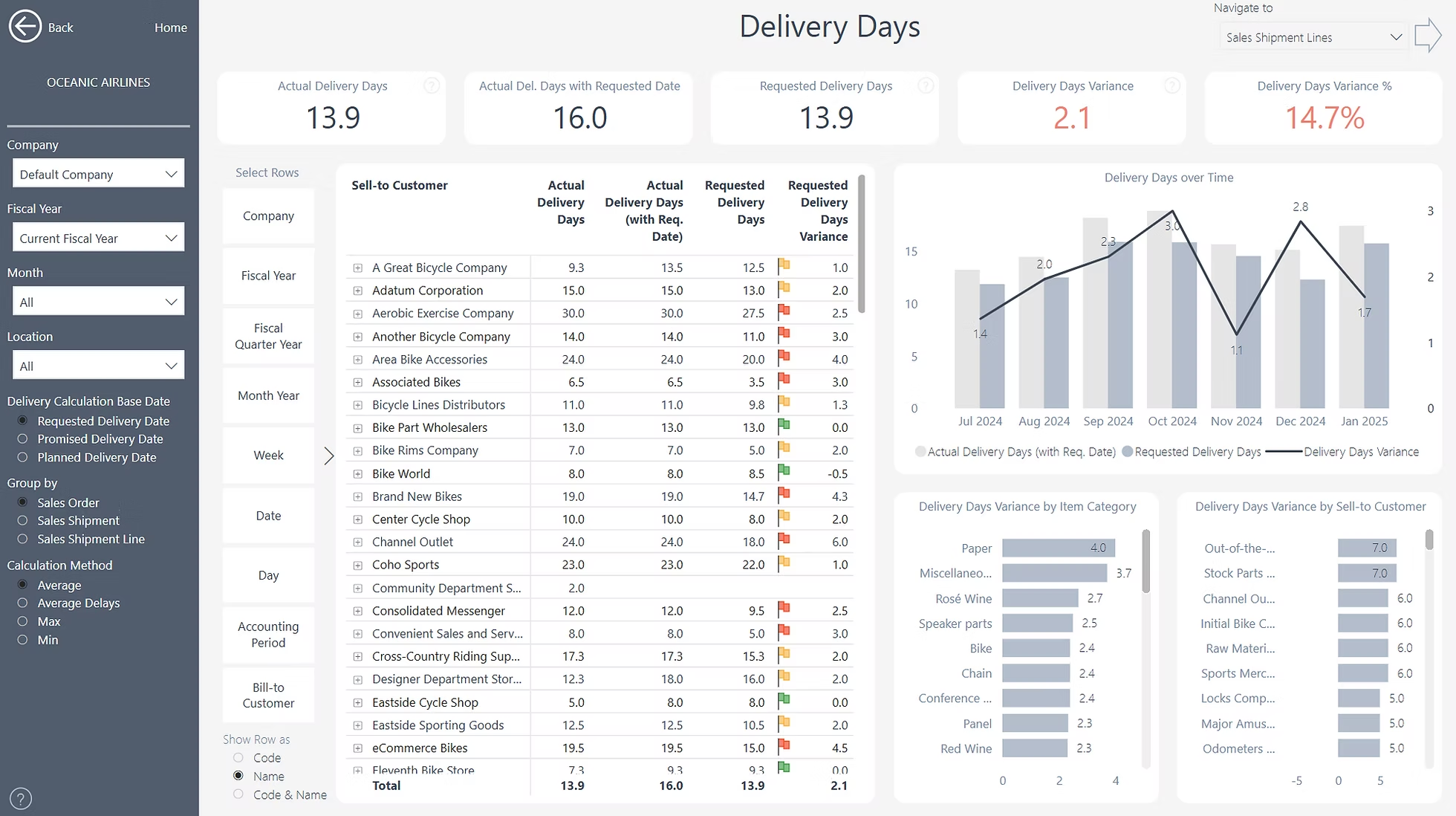
On-Time Delivery
On-time delivery significantly influences customer satisfaction and retention. Lower rates of timely deliveries can lead to increased complaints, higher customer service costs, and dissatisfied customers who may decide against future purchases.
The 'On-Time Delivery' report offers a critical lens to observe and evaluate the punctuality and reliability of your deliveries. By meticulously comparing total orders, shipments, or quantities against those delivered on time, this report provides invaluable insights into the efficiency of your logistics and fulfillment operations.
On-Time Delivery can be calculated based on the Requested, Promised, or Planned Delivery Date.
The 'On-Time Delivery' report considers a shipment line delivered on time if its actual delivery date is on or before the Requested, Promised, or Planned Delivery Date. In cases where the selected delivery date is not specified, the shipment is automatically classified as on-time. If you wish to exclude lines with blank Requested, Promised, or Planned Delivery Dates, you can easily filter them out using the Filter pane on the right side of the report.
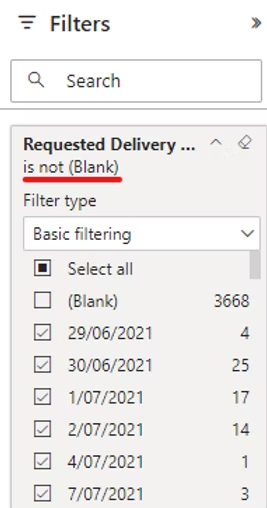
In the left-hand side menu, you can toggle between multiple measures, including:
Completely Shipped Sales Orders: This measure aligns closely with the Sales Order OTIF (On Time & In Full) metric. However, when interpreting this KPI, consider your order management practices in Business Central. For more information and limitations of the 'In Full' metric, refer to the section at the end of this document. The On-Time % is calculated as the total number of orders completely shipped on time divided by the total number of orders completely shipped.
Shipped Sales Orders: This measure accounts for your shipped sales orders, including partially shipped orders. The On-Time % is calculated as the total number of orders shipped (or partially shipped) on time divided by the total number of orders shipped (or partially shipped).
Shipped and Outstanding Sales Orders: This measure combines both outstanding and shipped sales orders. The On-Time % is calculated as the total number of orders that are shipped, partially shipped, or outstanding on time divided by the total number of placed orders (shipped, partially shipped, or outstanding). Outstanding Sales Orders are considered on time if the current date is before the Requested, Promised, or Planned Delivery Date.
Sales Shipments: This measure compares your total number of posted sales shipments with the total number of posted sales shipments delivered on time.
Sales Shipment Lines: This calculation is performed at the Sales Shipment line level.
Shipped Quantities: This measure displays total shipped quantities and compares them with the quantities shipped on time.
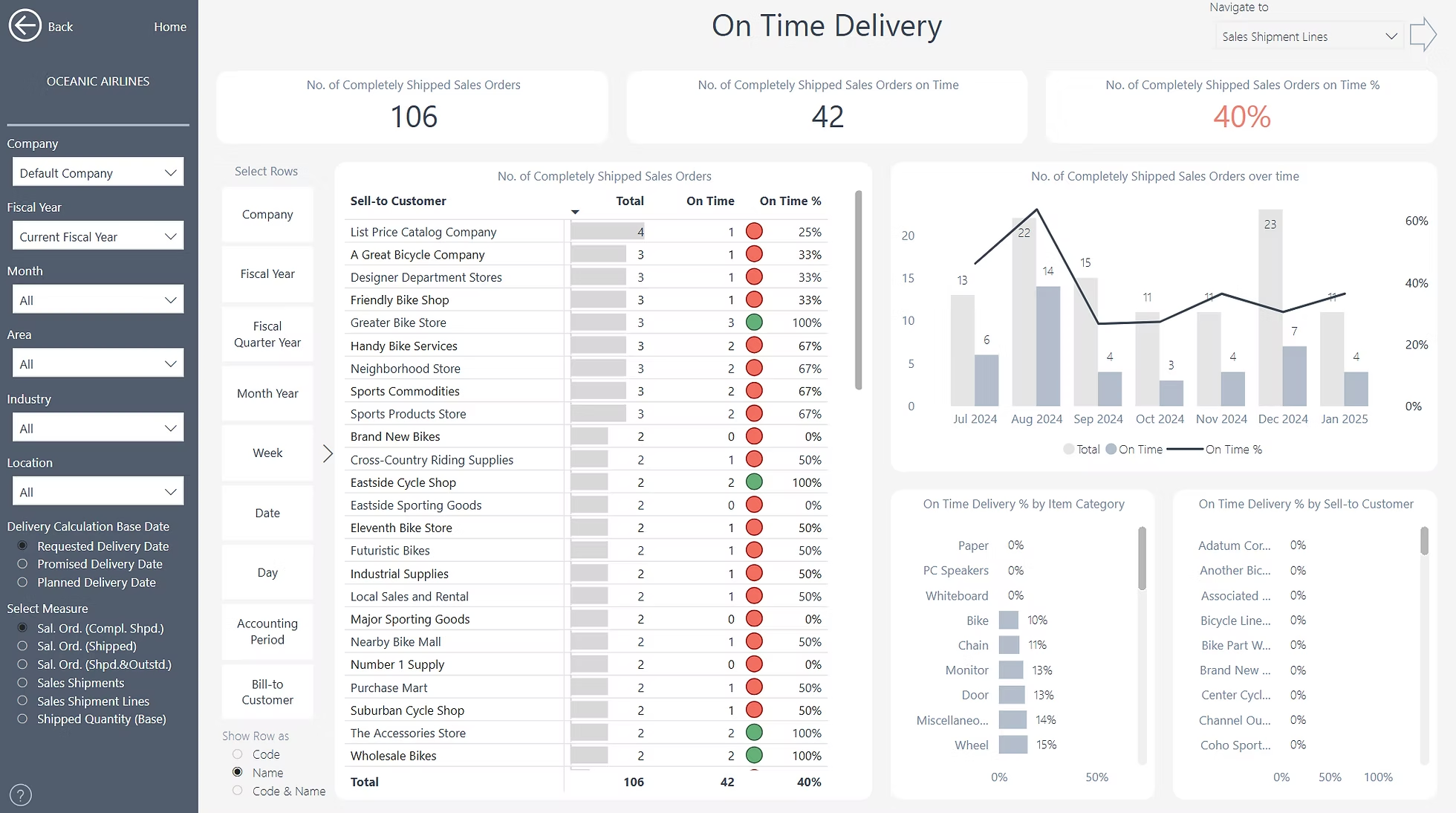
Fill Rate
The Fill Rate in wholesale and retail businesses measures the proportion of customer orders a company can fulfill using its available inventory, thereby avoiding stock shortages. It serves as one of the key indicators to evaluate how well the company’s supply chain is meeting sales demand.
Several types of fill rates are common in the industry:
Sales Order Fill Rate: A widely used metric assessing the ability to supply customer orders directly from stock (without backorders). It is calculated as the percentage of sales orders fully shipped in relation to the total number of orders, including both shipped and outstanding (pending) orders.
Sales Order Line Fill Rate: This metric calculates the percentage of individual order lines (items within an order) a company successfully delivers out of the total ordered. It highlights the completeness of supplying each specific item in an order.
Quantity Fill Rate: Especially important for distributors and wholesalers, this rate measures the percentage of the total ordered quantity that is shipped.
In (standard) Microsoft Business Central, the 'Fill Rate' and 'In Full' metrics have certain limitations, which are discussed in detail in the last section of this article.
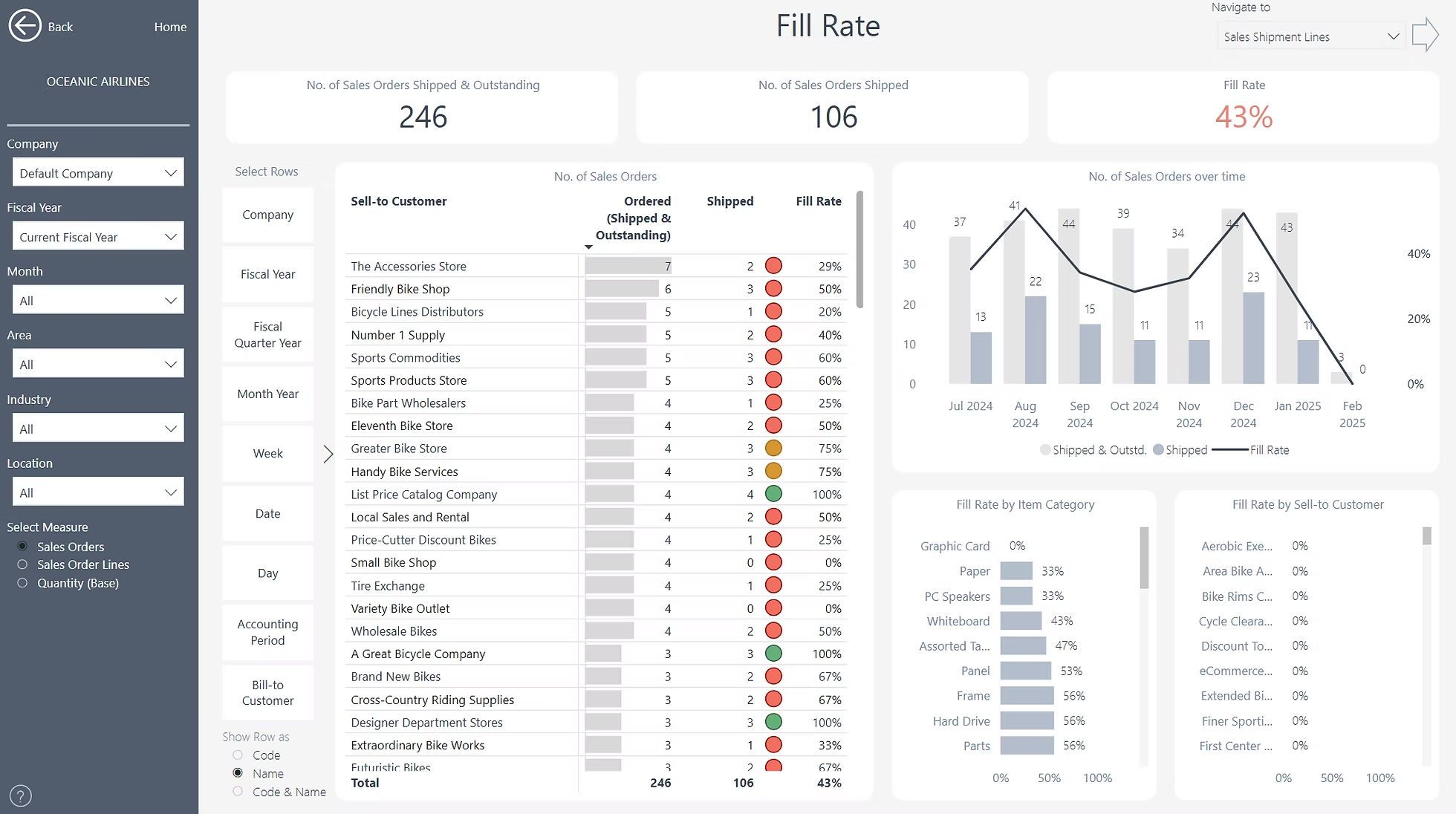
Delivery Cube and Delivery by Period
The 'Delivery Cube' report enables you to combine and analyze various delivery performance metrics side by side and to organize your data in the most insightful way for your analysis.
You can select multiple metrics or fields simultaneously using the CTRL + click shortcut. Additionally, you have the flexibility to customize your data visualization by selecting specific rows or columns, or by creating hierarchies with multiple fields. For detailed instructions on utilizing cube reports, please refer to the Business Central Insights Cube Tutorial.
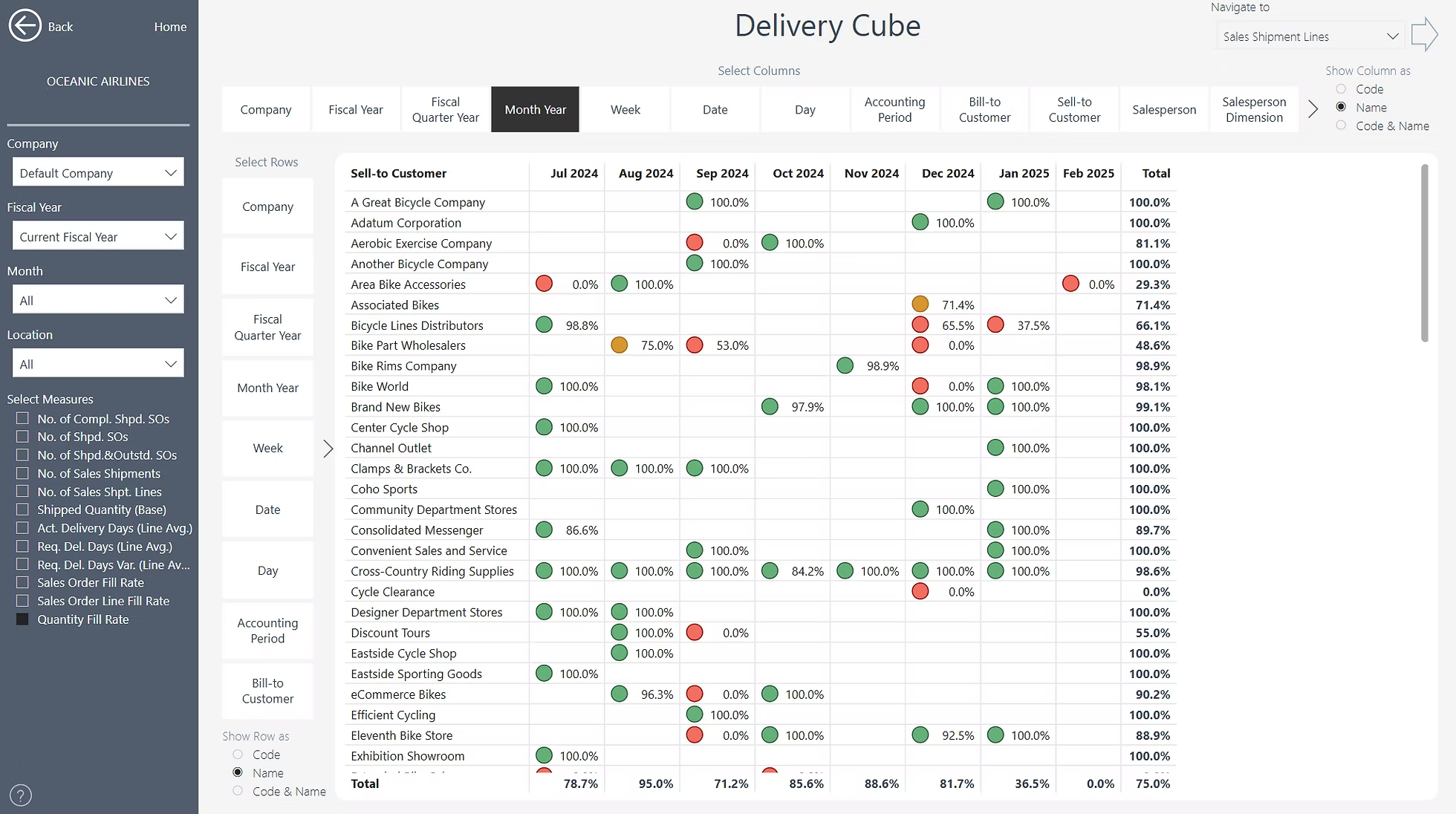
'Fill Rate' and 'In Full' Delivery Metrics Limitations in Business Central
In real-life scenarios, orders may not be completely shipped because some items might not be available or are significantly delayed. Business Central handles this in several ways, typically involving updates to open order lines. For instance, if the customer will not accept the delay, the remaining items and/or quantities could be simply deleted. Conversely, if the customer accepts the delay, the original order is either left with open lines until shipped (impacting on-time delivery metrics) or the original order is adjusted to actually delivered items/quantities and a new order is created with remaining items and/or quantities and with a new promised delivery date.
Maintaining a clean order book by removing obsolete or inadequate items is good practice and essential for consistent MRP and inventory planning. However, this maintenance affects the 'Fill Rate' and 'In Full' metrics, which are calculated against Business Central open orders. These limitations should be considered when interpreting these metrics, and we would advise to observe them coordinated with the orderbook cleaning periods.
Since Business Central Insights do not rely on workarounds dependent on implementation approaches, the Archived Sales Orders data may only be used as a customization (extension), considering the multitude of reasons an order or order line might be deleted or updated.
Other Linked Topics & Feedback
To analyze supplier delivery performance, please check the Receipt Days, On-Time Receipt, and Vendor Fill Rate reports in the Purchasing Insights app.
As always, please share your feedback with us. We are continually striving to improve our apps and will do our best to ensure your feedback is included in future release versions.